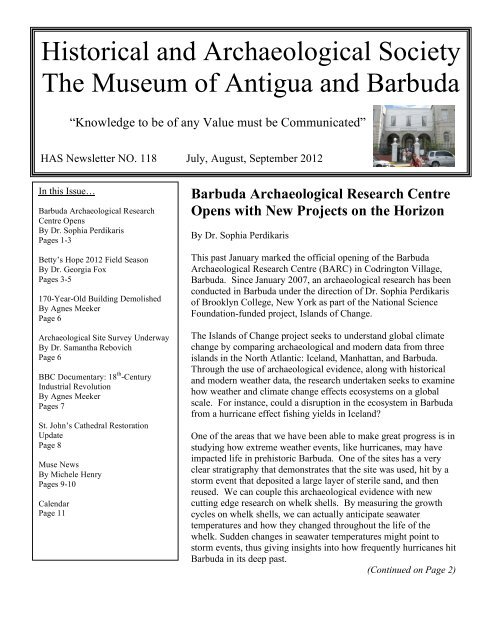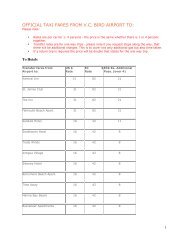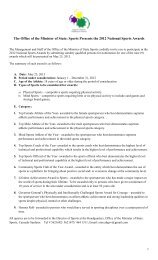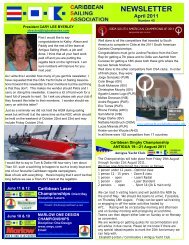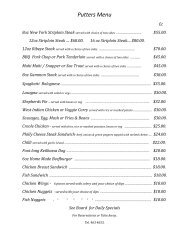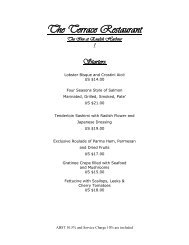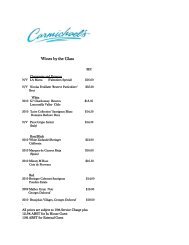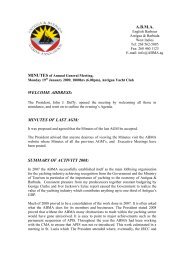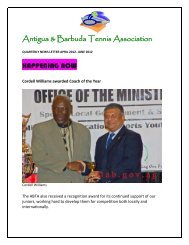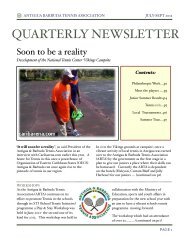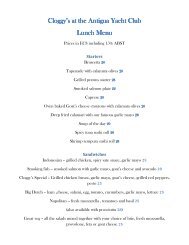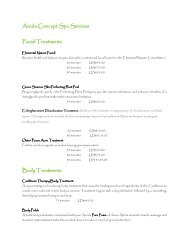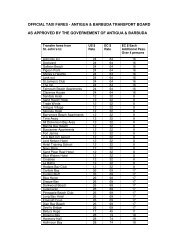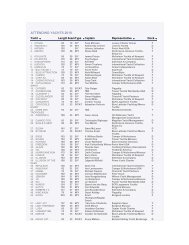here - Antigua Nice Ltd.
here - Antigua Nice Ltd.
here - Antigua Nice Ltd.
Create successful ePaper yourself
Turn your PDF publications into a flip-book with our unique Google optimized e-Paper software.
Historical and Archaeological Society<br />
The Museum of <strong>Antigua</strong> and Barbuda<br />
“Knowledge to be of any Value must be Communicated”<br />
HAS Newsletter NO. 118 July, August, September 2012<br />
In this Issue…<br />
Barbuda Archaeological Research<br />
Centre Opens<br />
By Dr. Sophia Perdikaris<br />
Pages 1-3<br />
Betty’s Hope 2012 Field Season<br />
By Dr. Georgia Fox<br />
Pages 3-5<br />
170-Year-Old Building Demolished<br />
By Agnes Meeker<br />
Page 6<br />
Archaeological Site Survey Underway<br />
By Dr. Samantha Rebovich<br />
Page 6<br />
BBC Documentary: 18 th -Century<br />
Industrial Revolution<br />
By Agnes Meeker<br />
Pages 7<br />
St. John’s Cathedral Restoration<br />
Update<br />
Page 8<br />
Muse News<br />
By Michele Henry<br />
Pages 9-10<br />
Calendar<br />
Page 11<br />
Barbuda Archaeological Research Centre<br />
Opens with New Projects on the Horizon<br />
By Dr. Sophia Perdikaris<br />
This past January marked the official opening of the Barbuda<br />
Archaeological Research Centre (BARC) in Codrington Village,<br />
Barbuda. Since January 2007, an archaeological research has been<br />
conducted in Barbuda under the direction of Dr. Sophia Perdikaris<br />
of Brooklyn College, New York as part of the National Science<br />
Foundation-funded project, Islands of Change.<br />
The Islands of Change project seeks to understand global climate<br />
change by comparing archaeological and modern data from three<br />
islands in the North Atlantic: Iceland, Manhattan, and Barbuda.<br />
Through the use of archaeological evidence, along with historical<br />
and modern weather data, the research undertaken seeks to examine<br />
how weather and climate change effects ecosystems on a global<br />
scale. For instance, could a disruption in the ecosystem in Barbuda<br />
from a hurricane effect fishing yields in Iceland<br />
One of the areas that we have been able to make great progress is in<br />
studying how extreme weather events, like hurricanes, may have<br />
impacted life in prehistoric Barbuda. One of the sites has a very<br />
clear stratigraphy that demonstrates that the site was used, hit by a<br />
storm event that deposited a large layer of sterile sand, and then<br />
reused. We can couple this archaeological evidence with new<br />
cutting edge research on whelk shells. By measuring the growth<br />
cycles on whelk shells, we can actually anticipate seawater<br />
temperatures and how they changed throughout the life of the<br />
whelk. Sudden changes in seawater temperatures might point to<br />
storm events, thus giving insights into how frequently hurricanes hit<br />
Barbuda in its deep past.<br />
(Continued on Page 2)
HAS Newsletter No. 118 Page 2<br />
July, August, September 2012<br />
Barbuda Archaeological Research Centre<br />
Opens with New Projects on the Horizon<br />
(cont.)<br />
Board of Directors<br />
Walter Berridge<br />
Chairman<br />
Reg Murphy<br />
President<br />
Agnes Meeker<br />
Secretary<br />
Janice Augustin<br />
Claudia Ruth Francis<br />
Clint Gilpin<br />
Len Moody-Stuart<br />
Samantha Rebovich<br />
Dawn Simon<br />
Dr. Sophia Perdikaris and Mr. Finch stand next to the newly installed<br />
NASA Weather Station in Barbuda.<br />
Though the larger scope of the project is a global comparative model, the<br />
research conducted in Barbuda also greatly helps to inform how sustainable<br />
lifestyles and practices can be built locally in <strong>Antigua</strong> and Barbuda as well.<br />
Recently, the sustainability of fishing the Barbuda lobster has come into<br />
question. Not only would this be devastating in terms of biodiversity, but<br />
it would also hugely impact the economy of Barbuda as many Barbudan<br />
fisherman depend on the lobster for their livelihood. With not just<br />
environmental but also community sustainability in mind, one of the new<br />
projects we are embarking on is an aquaponics station at BARC.<br />
Honourable Members<br />
Winston Derrick<br />
Edward T. Henry<br />
Her Excellency Dame<br />
Louise Lake-Tack<br />
Museum Staff<br />
Michele Henry<br />
Curator<br />
Debbie Joseph<br />
Gift Shop Clerk<br />
Myra Dyer<br />
Library Researcher<br />
Lavon Lawrence<br />
Data Base Clerk<br />
Library Researcher<br />
Carissa Daniel<br />
Heritage Interpretation<br />
Museum Attendant<br />
Jason Dyer<br />
Janitor<br />
Moislyn Joseph<br />
Cleaner<br />
CUNY Graduate Student, Mr. Norie Manigault speaks to a group of<br />
Barbudan school children who visited BARC this spring.<br />
(Continued on Page 3)
HAS Newsletter No. 118 Page 3<br />
July, August, September 2012<br />
Barbuda Archaeological<br />
Research Centre Opens with<br />
New Projects on the Horizon<br />
(cont.)<br />
Working with Mr. John Mussington, we have been<br />
able to integrate the development and maintenance<br />
of an aquaponics station into the secondary<br />
curriculum in Barbuda. Students would not only be<br />
responsible for maintaining the aquaponics station,<br />
raising fish and growing vegetables, in terms of an<br />
agricultural project, but are also responsible for<br />
making it sustainable as part of their business<br />
curriculum.<br />
In addition to working with schoolchildren in<br />
Barbuda, we are also seeking ways to integrate the<br />
entire community into the work we do. One of the<br />
areas archaeologists are interested in is in the<br />
historic and cultural use of landscapes. A new<br />
project launching this summer engages youth with<br />
elders in the community by having schoolchildren<br />
interview Barbudan elders about how they used to<br />
live. We expect this will give young Barbudans<br />
newfound appreciation for their homeland by<br />
emphasizing traditional practices and local histories.<br />
While we are launching these new projects this<br />
summer, the main focus of BARC is in protecting<br />
the heritage of Barbuda. BARC provides a facility<br />
from which researchers can work during field<br />
seasons but also provides a secure place for the<br />
storage of artifacts from Barbuda. We have also<br />
been able to dedicate some of the space in BARC to<br />
the development of exhibits so that schoolchildren,<br />
locals, and tourists alike can engage with the<br />
research being conducted in Barbuda and learn<br />
more about the island’s heritage.<br />
Betty’s Hope 2012 Field Season<br />
By Dr. Georgia Fox<br />
Each year, when we come out to Betty’s Hope, we<br />
can never be sure what we might find; the 2012<br />
summer field season, which ran from June 2 to June<br />
30, was no different. This year, we anticipated<br />
finding more floors and walls in the kitchen area of<br />
the Great House complex, yet these features, as well<br />
as others proved more spectacular than we could<br />
ever imagine.<br />
For those of you who know, and for those of you<br />
who are just reading about this for the first time, I<br />
have been conducting archaeological investigations<br />
at Betty’s Hope since the summer of 2007, under<br />
the aegis of the Betty’s Hope Trust, directed by<br />
island archaeologist and UNESCO Representative,<br />
as well as Director of Heritage Research and<br />
Archaeology for Nelson’s Dockyard National Park,<br />
Dr. Reginald Murphy. Archaeological work is<br />
conducted through a four-week field school through<br />
the Department of Anthropology at California State<br />
University, Chico (CSU Chico); also know more<br />
affectionately as “Chico State.” During their fourweek<br />
stint in the field, students learn the<br />
methodologies of field archaeology, which<br />
encompasses mapping and surveying, field<br />
excavation techniques, and processing the recovered<br />
artifacts.<br />
This year, we had 10 field school students,<br />
including: Michele Bechtel, Mark Belloni, Sofia<br />
Bikadou, Arik Bord, Jenna Farrington, Michele<br />
Garcia, Charlotte Goudge, Mary Swearingen, Alina<br />
Tichinin, and Megan Webb. Students came from<br />
California, as well as Indiana, and Britain. Three<br />
graduate students— Cate Davis, Genevieve<br />
Godbout, and Alexis Ohman— returned for a<br />
second year to carry out their respective research<br />
projects.<br />
(Continued on Page 4)
HAS Newsletter No. 118 Page 4<br />
July, August, September 2012<br />
Students normally spend long days in the field<br />
during the week, with a cooling off at the beach at<br />
the end of a busy day, followed by a weekly<br />
evening lecture, dinner, artifact cataloguing, and<br />
kitchen duty, and finally some down time. As<br />
students must be up and at breakfast by 6:00 am,<br />
morning arrives all too quickly! Weekends are<br />
spent on tours, visiting the island’s points of<br />
historical interest, as well as Nelson’s Dockyard,<br />
downtown St. John, and <strong>Antigua</strong>’s lovely beaches.<br />
Student in the 2012 Betty’s Hope Field School<br />
working on mapping the excavated remains.<br />
This year, in addition to our normally scheduled<br />
field program, we had a student film crew from the<br />
CSU Chico Department of Anthropology’s<br />
Advanced Laboratory for Visual Anthropology<br />
(ALVA). This was made possible by a grant from<br />
the university to create a film on archaeological<br />
field methodology to show to our archaeology<br />
courses during the academic year.<br />
The film crew, which comprised Santy Gray, Jake<br />
Martin, and Erin Smith, not only filmed at the site,<br />
but also went around the island, interviewing both<br />
tourists and locals about their thoughts on<br />
archaeology and cultural heritage tourism.<br />
Additionally, a crew from the BBC was present to<br />
film about the island’s history. They came out to<br />
Betty’s Hope for part of a day with their cameras—<br />
we were thrilled to have them at the site.<br />
In terms of the archaeology, it was a banner year,<br />
thanks not only to all of the students, but also to my<br />
trusty expert Teaching Assistants for the project,<br />
Christopher Waters and Cory Look. Chris is an MA<br />
student at Bristol University, England, and Cory is a<br />
doctoral student at Brooklyn College in New York;<br />
each brings their individual areas of expertise and<br />
skills, which greatly enhance the project, while<br />
working with the students. Both Chris and Cory<br />
have spent time in <strong>Antigua</strong>, and are fully adept at<br />
getting around the island. In fact, Chris came as a<br />
field school student himself for two field seasons,<br />
but was “promoted” to TA.<br />
Last year, in 2011, we uncovered several walls and<br />
floors of the Great House kitchen, which might<br />
have been a separate building. At the end of the<br />
2011 field season, we opened up an area at the side<br />
entrance to the house, opposite the windmills. We<br />
had originally excavated the area in 2007, but<br />
backfilled it with dirt for future excavation. In<br />
trying to determine the size of the Great House, the<br />
goal in this instance, was to follow a structural wall,<br />
known as Feature 33, to see w<strong>here</strong> it ended.<br />
Instead, what we got was something that we had not<br />
anticipated, but had always hoped for; a privy or<br />
“night soil” dump, which had excellent stratigraphy<br />
and artifacts dating from the seventeenth through<br />
nineteenth centuries. Unfortunately, because it was<br />
discovered at the end of the field season, we had to<br />
stop excavating, as time ran out. This feature will<br />
possibly be revisited at a later date, time permitting,<br />
as it was quite deep, and also revealed a very<br />
substantial structural wall that will need to be<br />
further investigated.<br />
Following the 2011 field season, the goals and<br />
objectives for this 2012 field season were to<br />
continue excavating the kitchen area of the Great<br />
House complex, more site survey and mapping, and<br />
(Continued on Page 5)
HAS Newsletter No. 118 Page 5<br />
July, August, September 2012<br />
more shovel tests to further explore tantalizing clues<br />
for other structures on the site. This includes the<br />
complex north of the Great House that is currently<br />
obscured by thick vegetation, as well as the area<br />
west of the Great House.<br />
Indeed we did find more floors and walls! As with<br />
most archaeological excavations, some of these<br />
features were discovered at the end of the field<br />
season, only to be investigated in 2013. Some of<br />
the artifacts we recovered this year included more<br />
buttons, imported ceramics, iron implements, and<br />
many hundreds of pieces of window glass and<br />
corroded iron nails.<br />
The 2012 Betty’s Hope Field School team.<br />
On a final note, next year, 2013, marks the 20 th<br />
anniversary of Dr. Murphy and his lovely wife,<br />
Nicki, hosting archaeological field schools,<br />
beginning with the Trent University Field School,<br />
the University of Calgary Field School, and then<br />
followed by Chico State. We owe a great deal of<br />
gratitude to the Murphy’s and all of our colleagues<br />
and friends who continue to support our research<br />
efforts at Betty’s Hope.<br />
Some of the excavated remains of the planter’s<br />
house uncovered during this summer’s field season.<br />
At this juncture, our real “treasure” at the site<br />
encompasses the walls and floors of these amazing<br />
structures. We also discovered to our surprise and<br />
delight that these features are matching up well with<br />
the archival documents in the Codrington Papers.<br />
Next year, we hope to continue exploring these<br />
promising areas. Chief among our goals is to locate<br />
the pre-emancipation slave housing, not an easy<br />
prospect, due to the ephemeral and organic nature<br />
of wattle and daub housing, which probably<br />
disintegrated long ago. Further impediments<br />
include the thick acacia and other vegetation that<br />
will have to be negotiated with a cutlass or two.<br />
Due to the lack of rainfall this field season,<br />
however, some features were much easier to see,<br />
unlike 2011, when it was much more prolific.<br />
Fun Fact!<br />
Did you know that<br />
J’ouvert is a contraction<br />
of the French words<br />
“jour” and “ouvert”<br />
meaning daybreak<br />
Thus j’ouvert literally<br />
refers to the breaking of<br />
dawn when the Carnival<br />
party happens!
HAS Newsletter No. 118 Page 6<br />
July, August, September 2012<br />
170-Year-Old Building Demolished<br />
By Agnes Meeker<br />
Just a few weeks ago a 170-year-old building with<br />
the date '1842' etched in the corner stone above one<br />
of the entrances to the building, met its fate with the<br />
wrecking ball. The two story building had been<br />
derelict for a number of years and was not only an<br />
eyesore in a predominantly tourist section of St<br />
John's, but had been and probably still was, home to<br />
several vagrants. The place emitted a strong<br />
stench, was filled with debris and garbage and was<br />
probably infested with rats.<br />
The building definitely needed to be removed and<br />
the area cleaned up. However, it would have been<br />
prudent to retain the lower front facade for its<br />
historical value and to incorporate it into whatever<br />
plans the owner/developer has in mind.<br />
Since this did not happen, it is hoped that whatever<br />
building replaces '1842' that the architect will bear<br />
in mind that we are in the Caribbean, that we<br />
depend on tourism and design a structure that will<br />
enhance and retain our heritage.<br />
See Newsletter article done on this building in 2010<br />
for further information.<br />
This 170-year old building in Redcliffe Quay was<br />
recently demolished.<br />
The cornerstone of the building marks the date it<br />
was built.<br />
Archaeological Site Surveys<br />
Underway<br />
By Dr. Samantha Rebovich<br />
This summer, staff from the Heritage and<br />
Environment Departments of the National Parks<br />
Authority (NPA) are revisiting archaeological sites<br />
in <strong>Antigua</strong> to assess their status and develop a<br />
Geographic Information System (GIS) map that will<br />
be used by the government and the Museum. Over<br />
526 archaeological and natural sites have been<br />
identified in <strong>Antigua</strong> and Barbuda, mostly through<br />
the pioneering efforts of Desmond Nicholson.<br />
Many of these sites, though, have been disturbed or<br />
destroyed by the ravages of time, natural disasters,<br />
and development. The NPA is developing a cultural<br />
heritage map in which archaeological sites and<br />
historic structures will be identified and ranked<br />
according to their cultural importance and state of<br />
preservation. To date, 86 sites have been visited<br />
and mapped with the help of interns from the<br />
University of the West Indies-St. Augustine.<br />
Creating this map will allow other government<br />
departments, such as DCA, Survey, and APUA to<br />
check for heritage sites before conducting work or<br />
approving development in <strong>Antigua</strong>. This should<br />
help to preserve our heritage better and make us all<br />
more responsible in protecting <strong>Antigua</strong>’s past.
HAS Newsletter No. 118 Page 7<br />
July, August, September 2012<br />
BBC Documentary: 18 th -<br />
Century Industrial Revolution<br />
By Agnes Meeker<br />
A group of four from the BBC directed by Charles<br />
Colville, recently spent four days in <strong>Antigua</strong> to put<br />
together part of a 60-minute documentary depicting<br />
the Industrial Revolution in England during the 18th<br />
century (1700’s). It was an era when steam was<br />
developed and it was driven and attributed to the<br />
wealth of the sugar barons of the West Indies.<br />
The narrator for the series, due to air in January of<br />
2013, is Professor Jeremy Blade from Exeter<br />
University. The BBC has promised a copy to the<br />
Museum of <strong>Antigua</strong> & Barbuda and we will have a<br />
showing to the public upon receipt in the hope that<br />
not too much of the <strong>Antigua</strong> footage ends up on the<br />
cutting floor!<br />
This old photograph shows the steam engine at<br />
Montpelier Sugar Factory. The engine is dated<br />
1890 and was manufactured in Glasgow by<br />
McOnie, Harvie, and Co.<br />
The BBC team spent four days in <strong>Antigua</strong> filming<br />
for their upcoming documentary.<br />
The original steam engine was a massive affair<br />
developed by Thomas Newcomen in 1712. This<br />
was later further developed and refined by a Scot<br />
James Watt to whom this invention has been<br />
attributed. By the end of the 1700’s t<strong>here</strong> were over<br />
2,100 steam engines. The steam locomotives and<br />
boats came into being around 1815.<br />
Areas visited in <strong>Antigua</strong> not only included some of<br />
<strong>Antigua</strong>’s well known sites such as Half Moon Bay,<br />
the Dockyard and Shirley Heights but hidden<br />
historical treasures such as Montpelier Sugar<br />
Factory, Herbert’s estate house built in 1742,<br />
Royals estate settled by Isaac Royal in the late<br />
1600’s, the Tranquil Vale slave dungeon and a<br />
stand of sugar cane which was the hardest to locate.<br />
A 1712 Plan of Thomas Newcomen’s original steam<br />
engine.
HAS Newsletter No. 118 Page 8<br />
July, August, September 2012<br />
The St. John’s Cathedral<br />
Restoration Update<br />
By Bruce Arrindell<br />
Since 201 the St. John’s Cathedral has been closed<br />
to undergo repairs and restoration. The Cathedral<br />
overlooks our capital of St. John’s and her twin<br />
towers serve as a landmark for the city and its<br />
environs as well as a navigation mark for the<br />
fisherman. Besides the historical and religious<br />
significance to Anglicans, the Cathedral is also<br />
regarded with reverence and affection by many<br />
<strong>Antigua</strong>ns who are not of the Anglican faith.<br />
Efforts are now underway to pass the necessary<br />
legislation to declare the St. John’s Cathedral a<br />
National Heritage Site.<br />
Work continues to rebuild the Cathedral and restore<br />
it to its former glory. Most recently, the roof over<br />
the sanctuary has been completed. It was decided to<br />
replace it with a concrete roof. All of the old<br />
timbers under the roof were removed and replaced<br />
with new lumber. Metal sheets from the old roof<br />
were reused as part of the formwork for the<br />
concrete roof. The stones in the parapet wall were<br />
cracked and loose in places so a short wall was cast<br />
behind them to hold them together.<br />
Because the sanctuary roof is relatively small and<br />
intricate, concrete could not be pumped up to the<br />
roof and instead was mixed in the churchyard and<br />
hauled up the old-fashioned way, bucket by bucket.<br />
Once the drains in the Cathedral are completed, the<br />
entire roof and drain system within the Cathedral<br />
will be brand new. This marks a huge step forward<br />
in the completion of the restoration.<br />
Buckets are used to bring concrete up to the roof<br />
over the sanctuary.<br />
The two statues of St. John that mark the entrance<br />
gate to the grounds of St. John’s Cathedral were<br />
captured from a French ship.<br />
If you would like to follow and contribute to the<br />
restoration of the Cathedral of St. John the Divine<br />
you can do so at the websites listed below:<br />
www.stjohnthedivineantigua.com<br />
http://stjohnsrestoration.blogspot.com/<br />
The Cathedral before development encroached upon<br />
its grounds.
HAS Newsletter No. 118 Page 9<br />
July, August, September 2012<br />
Muse News<br />
By Michele Henry<br />
Every Board Counts!<br />
The Historical and Archaeological Society has had<br />
to undertake emergency repairs to the ceilings in the<br />
Museum of <strong>Antigua</strong> and Barbuda. The Public<br />
Works Department is assisting with the labour and<br />
we are providing all of the materials for the repairs.<br />
The Historical Society is the keeper of the cultural<br />
patrimony of <strong>Antigua</strong> and Barbuda and, as such, we<br />
need to preserve it in a safe environment.<br />
We understand at this time you may not be able to<br />
give a substantial amount but any little bit helps<br />
towards every single board.<br />
The emergency repairs have meant that we have had<br />
to suspend some of our planned events at the<br />
museum for the summer.<br />
Country Manager of RBTT, Cassandra Ryan, signs<br />
the Donor Board while Country Manager of RBC,<br />
Robin Shaw, looks on. The merged banks made a<br />
generous contribution to the project.<br />
Hopefully, in late July, ceilings repairs will begin in<br />
the Research Library and the Gift Shop and the<br />
Museum can remain open for the duration of this<br />
work.<br />
Walter Berridge, Chairman of the Historical and<br />
Archaeological Society, accepts a cheque from<br />
State Insurance for $10,800 for the restoration of<br />
the ceilings!!<br />
Walter Berridge, Chairman of the Historical and<br />
Archaeological Society, presents copies of Dr.<br />
Nicholas Fuller’s book to RBTT Manager,<br />
Cassandra Ryan, and RBC Manager, Robin Shaw,<br />
as a token of appreciation.
HAS Newsletter No. 118 Page 10<br />
July, August, September 2012<br />
Restoration Donors<br />
• Government of <strong>Antigua</strong> and Barbuda<br />
• State Insurance Corporation<br />
• Price Water House Coopers<br />
• E. Ann Henry<br />
• National Parks Authority<br />
• Yvonne Bayrd<br />
• The Camera Shop<br />
• Walter Berridge<br />
• Cheryl Carter<br />
• Tradewinds Hotel <strong>Antigua</strong> LTD<br />
• J. Arlene Winter<br />
• Elvis Weaver<br />
• Rosemary Magaris<br />
• Gillian K. Derrick<br />
• Kim A. Derrick<br />
• Tamara Varney<br />
• Robert Corroon Jr.<br />
• Dr & Mrs R Alford & Myra Walwyn<br />
• Jennifer Meranto<br />
• Ruby Tang<br />
• Len & Joyce Moody-Stuart<br />
• Bob & Agnes Meeker<br />
• Jane Seagull<br />
• Carole Schlott Donelan<br />
• Luke R K & Sons<br />
• The Embassy of the People’s Republic of<br />
China<br />
Mys-toric Tours of St. John’s<br />
Museum/GARDC certified tour guides are offering<br />
mys-toric tours (mystery and history) tours of St.<br />
John’s. The tours include:<br />
1. The 350 year old City – to find the 100<br />
window house, and w<strong>here</strong> King Court lived<br />
2. St. John’s Harbour – Would you believe that<br />
St. John’s Harbour started from Five<br />
Islands<br />
3. Pirates and Privateers – Why did <strong>Antigua</strong>n<br />
Governors employ pirates and privateers<br />
4. City Walk, Historic Architecture – The<br />
mystery of stone, wood, and masonry<br />
architecture<br />
5. From Market to Table – the Public Market,<br />
fruits, vegetables, and secret recipes<br />
6. National Heroes Tour – King Court, Sir<br />
Vivian Richards<br />
Whether you are a child or an adult, these<br />
authentically researched tours will fascinate you.<br />
Come join us, get to know about your history in a<br />
relaxed way. You choose your own time. Tours<br />
offered to schools, church groups, family reunions,<br />
camps, or individuals. Just call 462-4930/462-1469<br />
to book your tour. Special rates apply. Adults<br />
$10.00/Children $5.00<br />
New Members<br />
• Anthony Bento<br />
• Irma Pringle<br />
• Cecil A. Camacho<br />
• Richard Dingwall<br />
• Louise Sandiford<br />
• Alicia Lee Isaac (Life member)<br />
• Janet Kipling<br />
Children get ready to embark on a Mys-toric Tour!
HAS Newsletter No. 118 Page 11<br />
July, August, September 2012<br />
Historical and Archaeology Society<br />
July, August, September 2012 HAS NEWSLETTER, No. 118<br />
Upcoming Events<br />
Please note all events at the Museum have been cancelled due to emergency repairs to the ceiling<br />
of the building. Please check our website and Facebook page for updates and events as they are<br />
schedule!<br />
Join HAS! Discover & Preserve <strong>Antigua</strong> & Barbuda’s Heritage


